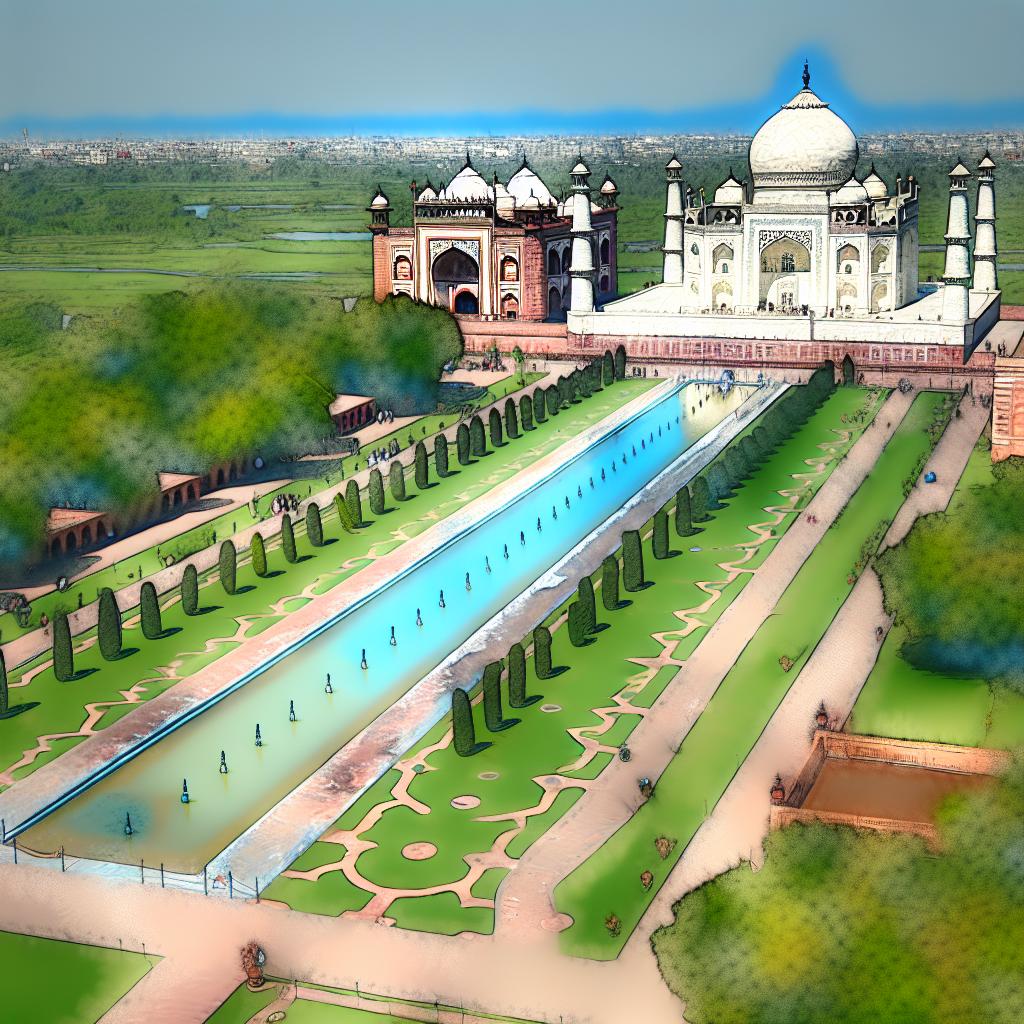Contents
The Taj Mahal: An Overview of its Grounds and Structures
The Taj Mahal, situated in Agra, India, is widely recognized as a quintessential example of Mughal architecture. Commissioned by the Mughal Emperor Shah Jahan in the year 1632, the complex is illustrious not just for its principal mausoleum but for the plethora of intricate elements spread across its vast grounds. This architectural marvel is an embodiment of Indian, Persian, and Islamic design traditions seamlessly woven together.
The Layout of the Taj Mahal Complex
Encompassing an area of roughly 42 acres, the Taj Mahal’s grounds feature several noteworthy components that draw millions of visitors from around the world each year. Upon entering through the towering main gateway, also referred to as the darwaza, visitors encounter sprawling gardens and tranquil reflecting pools. These elements are thoughtfully organized in a garden layout known as the charbagh, a staple of Persian garden design that reflects an idea of paradise on earth by dividing the space into four equal parts.
The Main Mausoleum and Its Architectural Significance
The crown jewel of the entire complex is undeniably the main mausoleum. Within its marble confines rests the tombs of Shah Jahan and his beloved wife, Mumtaz Mahal. The design showcases a symmetrical formation crowned by a monumental central dome, with smaller domes positioned around it. Adding to its grandeur are the four towering minarets positioned at each corner of the plinth, extending an air of completeness and protection. The structure becomes an exemplar of Mughal architectural brilliance with its exquisite embellishments—gemstones inlaid into the marble and meticulous carvings—highlighting the remarkable craftsmanship that defined that period.
The Mosque and the Guesthouse
To the west of the mausoleum stands a mosque, constructed from red sandstone. This place of worship signifies the complex’s religious importance and provides a space for prayer and reflection. To preserve aesthetic balance and symmetry, a guesthouse, known as the jawab, is situated directly to the east. Though the jawab is not used for religious purposes, it mirrors the mosque’s architectural style, contributing harmoniously to the complex’s visual equilibrium.
The Cultural and Historical Context
More than just a physical structure, the Taj Mahal represents a significant era in historical tapestry, marking the zenith of Mughal architectural achievement. Its design is infused with cultural meanings that are deeply embedded in the traditions and beliefs of the time, especially those linked to paradise as described in Islamic theology. The gardens, water features, and the alignment of the buildings within the complex encapsulate symbolic elements that underscore the perception of divine paradise.
Experiencing the Taj Mahal offers a dive into the rich and vibrant history of an era that prided itself on artistic and cultural accomplishments. The combination of visual beauty and profound history makes it a standing testament to a bygone era of grandeur.
The Gardens and Waterworks
The gardens of the Taj Mahal are not merely ornamental but play a crucial role in the complex’s thematic representation. The most striking aspect is the charbagh layout, designed to reflect the mention of paradise gardens in Islamic scriptures. Symmetrically dissected into four quadrants by raised pathways and water channels, these gardens create a sense of tranquility, further emphasized by the reflection of the mausoleum in the pools. Such reflections are symbolic, embodying the ephemeral and reflective nature of life itself.
The Remarkable Craftsmanship
Beneath the overwhelming visual appeal lies the painstaking craftsmanship that contributes to the Taj Mahal’s status as a wonder of the world. The mausoleum and other structures feature intricate pietra dura work, a technique that involves embedding precious stones into marble to create elaborate floral and geometric patterns. The meticulous attention to detail is also evident in the calligraphic art, primarily passages from the Quran, which add another layer of cultural and religious significance to the site.
Preservation and Conservation Efforts
Preserving the Taj Mahal has been an ongoing commitment, reflective of its importance as a symbol of cultural heritage. Conservation efforts continually address challenges such as environmental pollution and the impacts of tourism. These efforts underscore the significance of the Taj Mahal as not merely a historical artifact but as a continuously relevant symbol of architectural and cultural ingenuity.
For those intending to visit this UNESCO World Heritage Site, it is advisable to stay informed about visiting hours, special guidelines, and any conservation initiatives taking place. Updated information can always be accessed on the official Archaeological Survey of India website.
In sum, the Taj Mahal is more than a love story wrought in marble; it is a resonant legacy of a civilization that esteemed beauty, symmetry, and the sublime art of architectural storytelling. The complex, in every aspect, narrates not just the history of a royal couple, but also the thriving cultural context of 17th-century India. As such, it remains a crucial anchor within the timeless dialogue between history and magnificence.

